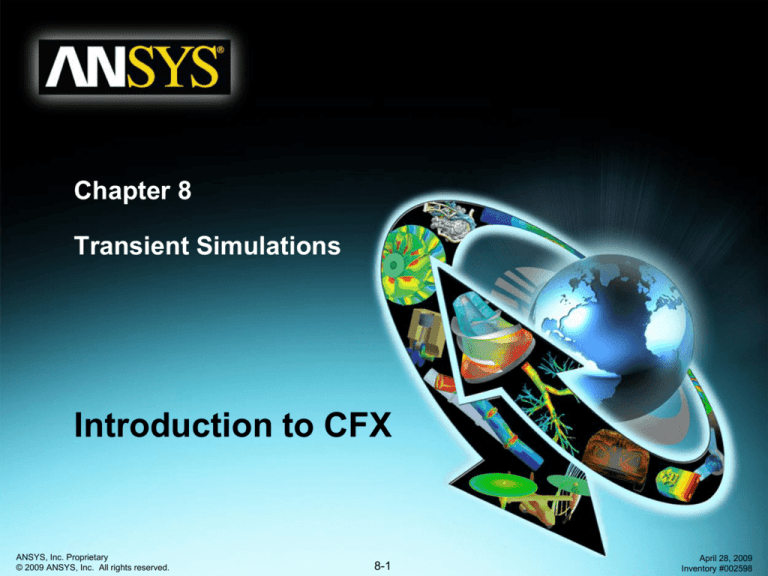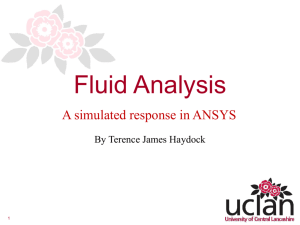
Chapter 8
Transient Simulations
Introduction to CFX
ANSYS, Inc. Proprietary
© 2009 ANSYS, Inc. All rights reserved.
8-1
April 28, 2009
Inventory #002598
Transient Simulations
Motivation
Training Manual
• Nearly all flows in nature are transient!
– Steady-state assumption is possible if we:
• Ignore unsteady fluctuations
• Employ ensemble/time-averaging to remove unsteadiness (this is what is done
in modeling turbulence)
• In CFD, steady-state methods are preferred
– Lower computational cost
– Easier to postprocess and analyze
• Many applications require resolution of transient flow:
–
–
–
–
–
–
Aerodynamics (aircraft, land vehicles,etc.) – vortex shedding
Rotating Machinery – rotor/stator interaction, stall, surge
Multiphase Flows – free surfaces, bubble dynamics
Deforming Domains – in-cylinder combustion, store separation
Unsteady Heat Transfer – transient heating and cooling
Many more
ANSYS, Inc. Proprietary
© 2009 ANSYS, Inc. All rights reserved.
8-2
April 28, 2009
Inventory #002598
Transient Simulations
Origins of Transient Flow
Training Manual
• Natural unsteadiness
– Unsteady flow due to growth of instabilities within the fluid or a non-equilibrium
initial fluid state
– Examples: natural convection flows, turbulent eddies of all scales, fluid waves
(gravity waves, shock waves)
• Forced unsteadiness
– Time-dependent boundary conditions, source terms drive the unsteady flow field
– Examples: pulsing flow in a nozzle, rotor-stator interaction in a turbine stage
Kelvin-Helmholtz Cloud Instability
ANSYS, Inc. Proprietary
© 2009 ANSYS, Inc. All rights reserved.
Rotor-Stator Interaction in an Axial Compressor
8-3
April 28, 2009
Inventory #002598
Transient Simulations
Transient CFD Analysis
Training Manual
• Simulate a transient flow field over a specified time period
– Solution may approach:
• Steady-state solution – Flow variables stop changing with time
• Time-periodic solution – Flow variables fluctuate with repeating pattern
– Your goal may also be simply to analyze the flow over a prescribed time
interval.
• Free surface flows
• Moving shock waves
• Etc.
• Extract quantities of interest
– Natural frequencies (e.g. Strouhal Number)
– Time-averaged and/or RMS values
– Time-related parameters (e.g. time required to cool a hot solid, residence
time of a pollutant)
– Spectral data – fast Fourier transform (FFT)
ANSYS, Inc. Proprietary
© 2009 ANSYS, Inc. All rights reserved.
8-4
April 28, 2009
Inventory #002598
Transient Simulations
How to Solve a Transient Case
• Transient simulations are
solved by computing a solution
for many discrete points in time
• At each time point we must
iterate to the solution
2
4 6 8 10 12 14 16 18 20
Timestep = 2 s
Initial Time = 0 s
Total Time = 20 s
Coefficient Loops = 5
5 coefficient
Loops
Time (seconds)
ANSYS, Inc. Proprietary
© 2009 ANSYS, Inc. All rights reserved.
Training Manual
8-5
April 28, 2009
Inventory #002598
Transient Simulations
How to Solve a Transient Case
Training Manual
• Similar setup to steady state
• The general workflow is
1. Set the Analysis Type to Transient
2. Specify the transient time duration to solve and the time step size
3. Set up physical models and boundary conditions as usual
– Boundary conditions may change with time
4. Prescribe initial conditions
– Best to use a physically realistic initial condition, such as a steady
solution
5. Assign solver settings
6. Configure transient results files, transient statistics, monitors points
7. Run the solver
ANSYS, Inc. Proprietary
© 2009 ANSYS, Inc. All rights reserved.
8-6
April 28, 2009
Inventory #002598
Transient Simulations
1. Analysis Type
Training Manual
• Edit Analysis Type in the Outline tree and set the option to Transient
ANSYS, Inc. Proprietary
© 2009 ANSYS, Inc. All rights reserved.
8-7
April 28, 2009
Inventory #002598
Transient Simulations
2. Time Duration and Time Step
Training Manual
• Set the Time Duration
– This controls when the simulation will end
• Options are:
– Total Time
• When restarting this time carriers over
– Time Per Run
• Ignores any time completed in previous runs
– Maximum Number of Timesteps
• The number of timesteps to perform, including
any completed in previous runs
– Number of Timesteps per Run
• For this run only. Ignores previously
completed timesteps
ANSYS, Inc. Proprietary
© 2009 ANSYS, Inc. All rights reserved.
8-8
April 28, 2009
Inventory #002598
Transient Simulations
2. Time Duration and Time Step
Training Manual
• Set the Time Step size
– This controls the spacing in time between
the solutions points
• Options are:
– Timesteps / Timesteps for the Run
•
•
•
•
Various formats accepted, e.g.
0.001
0.001, 0.002, 0.002, 0.003
5*0.001, 10*0.05, 20*0.06
– Adaptive
• Timestep size will change dynamically within
specified limits depending on specified
convergence criteria or Courant number
ANSYS, Inc. Proprietary
© 2009 ANSYS, Inc. All rights reserved.
8-9
April 28, 2009
Inventory #002598
Transient Simulations
2. Time Duration and Time Step
Training Manual
• The Time Step size is an important parameter in transient simulations
– It must be small enough to resolve time-dependent features …
Time step too large to resolve transient
changes. Note the solution points generally
will not lie on the true solution because the
true behaviour has not been resolved.
True solution
Variable of
interest
Dt
Time
A smaller time step can
resolve the true solution
Variable of
interest
Dt
Time
ANSYS, Inc. Proprietary
© 2009 ANSYS, Inc. All rights reserved.
8-10
April 28, 2009
Inventory #002598
Transient Simulations
2. Time Duration and Time Step
Training Manual
– … and it must be small enough to maintain solver stability
• The quantity of interest may be changing very slowly (e.g. temperature in a
solid), but you may not be able to use a large timestep if other quantities (e.g.
velocity) have smaller timescales
• The Courant Number is often used to estimate a time step:
Velocity Dt
Courant Number
Element Size
– This gives the number of mesh elements the fluid passes through in one
timestep
– Typical values are 2 – 10, but in some cases higher values are acceptable
– The average and maximum Courant number is reported in the Solver out
file each timestep
• A smaller timestep will typically improve convergence
ANSYS, Inc. Proprietary
© 2009 ANSYS, Inc. All rights reserved.
8-11
April 28, 2009
Inventory #002598
Transient Simulations
3. Boundary Conditions
Training Manual
• If required, boundary conditions can be functions of time instead of
constant values
– Velocities, Mass flows, pressure conditions, temperatures, etc. can all be
expressed as functions
– In CEL expressions use “t” or “Time”
– Can read in time varying experimental data through User FORTRAN
ANSYS, Inc. Proprietary
© 2009 ANSYS, Inc. All rights reserved.
8-12
April 28, 2009
Inventory #002598
Transient Simulations
4. Initialization
Training Manual
• Physically realistic initial conditions
should be used
• If a transient simulation is started from
an approximate initial guess the initial
transient will not be accurate
– The first few timesteps may not
converge
– A smaller time step may be needed
initially to maintain solver stability
– For cyclic behavior the first few cycles
can be ignored until a repeatable pattern
is obtained
ANSYS, Inc. Proprietary
© 2009 ANSYS, Inc. All rights reserved.
8-13
Residuals
– A converged steady state solution is
often used as the starting point
2
4 6 8 10 12 14 16
Time (seconds)
April 28, 2009
Inventory #002598
Transient Simulations
5. Solver Control
Training Manual
• The transient scheme defines the numerical
algorithm for the transient term
• Two implicit time-stepping schemes are
available:
– First Order Backward Euler (more stable)
– Second Order Backward Euler (more
accurate)
• The default Second Order Backward Euler
scheme is generally recommended for most
transient runs
• Timestep Initialisation controls the way the
previous timestep is used as the starting
point for the next timestep
– Can use the last solution “as is”
– Or the solver can extrapolate the previous
solution to try to provide a better starting
point
• Not recommended at high Courant numbers
– Automatic (default) switches between the two
depending on the Courant number
ANSYS, Inc. Proprietary
© 2009 ANSYS, Inc. All rights reserved.
8-14
April 28, 2009
Inventory #002598
Transient Simulations
5. Solver Control
Training Manual
• The Min. and Max. Coeff. Loops set limits
on the number of iterations to use within
each timestep
• Should aim to converge each timestep
within about 3 – 5 loops
– Complex physics may need more loops
• If convergence is not achieved in the
maximum number of loops, it is generally
better to reduce the timestep size rather
than increase the number of loops
– The solution will proceed to the next
timestep regardless of whether the
convergence criteria was met
– Important to monitor the solution
ANSYS, Inc. Proprietary
© 2009 ANSYS, Inc. All rights reserved.
8-15
April 28, 2009
Inventory #002598
Transient Simulations
6. Output Control
Training Manual
• Transient Results
– By default only a final res file is written
• No information about the transient solution
– Need to define Transient Results under
Output Control
• Transient Results Option
– Standard
• Like a full results file
• Can take up a lot of disk space
– Smallest
• Writes the smallest file which can still be
used for a restart (still quiet large)
– Selected Variables
• Pick only the variables of interest to give
smaller files
• Output Frequency
– Controls how often results are written
ANSYS, Inc. Proprietary
© 2009 ANSYS, Inc. All rights reserved.
8-16
April 28, 2009
Inventory #002598
Transient Simulations
6. Output Control
Training Manual
• Transient Statistics
– Used to generate running statistics for
solution variables
• Arithmetic Average, RMS, Minimum,
Maximum, Standard Deviation and Full
(everything) are available options
• Pick the variables of interest
• Start and Stop Iteration List defines
when to begin and end collecting the
statistics
ANSYS, Inc. Proprietary
© 2009 ANSYS, Inc. All rights reserved.
8-17
April 28, 2009
Inventory #002598
Transient Simulations
6. Output Control
Training Manual
• Monitor Points are generally used as in
steady-state simulations
• Monitor Coefficient Loop Convergence
creates monitor history for each
iteration within a timestep
– Useful to see if quantities of interest are
converging within a timestep
– By default only the monitor values from
the end of the timestep are displayed
• Tip: Monitoring an expression will
create a transient history chart in the
Solver Manager. This can be easier
than creating the chart from transient
results files after-the-fact, and it doesn’t
require transient results files to be
written
ANSYS, Inc. Proprietary
© 2009 ANSYS, Inc. All rights reserved.
8-18
April 28, 2009
Inventory #002598
Transient Simulations
7. Solver Output
Training Manual
• Output differs from steady
state in that each time step
now contains coefficient loop
output
• Courant number information
shown at the start of each
timestep
• Make sure convergence has
been achieved by the end of
the timestep by monitoring
the RMS and MAX residual
plots
ANSYS, Inc. Proprietary
© 2009 ANSYS, Inc. All rights reserved.
8-19
April 28, 2009
Inventory #002598


